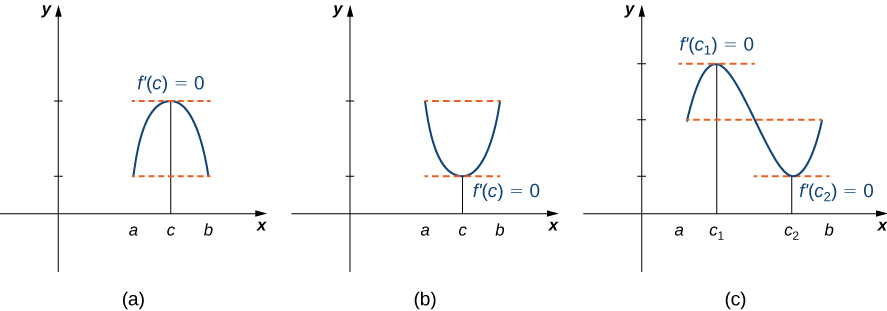- Use Rolle’s theorem and the Mean Value Theorem to show how functions behave between two points
- Discuss three key implications of the Mean Value Theorem for understanding function behavior
The Mean Value Theorem
The Mean Value Theorem is one of the most important theorems in calculus. We look at some of its implications at the end of this section. First, let’s start with a special case of the Mean Value Theorem, called Rolle’s theorem.
Rolle’s Theorem
Informally, Rolle’s theorem states that if the outputs of a differentiable function [latex]f[/latex] are equal at the endpoints of an interval, then there must be an interior point [latex]c[/latex] where [latex]f^{\prime}(c)=0[/latex]. Figure 1 illustrates this theorem.

Rolle’s theorem
Let [latex]f[/latex] be a continuous function over the closed interval [latex][a,b][/latex] and differentiable over the open interval [latex](a,b)[/latex] such that [latex]f(a)=f(b)[/latex]. There then exists at least one [latex]c \in (a,b)[/latex] such that [latex]f^{\prime}(c)=0[/latex].
Proof
Let [latex]k=f(a)=f(b)[/latex]. We consider three cases:
- [latex]f(x)=k[/latex] for all [latex]x \in (a,b)[/latex].
- There exists [latex]x \in (a,b)[/latex] such that [latex]f(x)>k[/latex].
- There exists [latex]x \in (a,b)[/latex] such that [latex]f(x) < k[/latex].
Case 1: If [latex]f(x)=k[/latex] for all [latex]x \in (a,b)[/latex], then [latex]f^{\prime}(x)=0[/latex] for all [latex]x \in (a,b)[/latex].
Case 2: Since [latex]f[/latex] is a continuous function over the closed, bounded interval [latex][a,b][/latex], by the extreme value theorem, it has an absolute maximum. Also, since there is a point [latex]x \in (a,b)[/latex] such that [latex]f(x)>k[/latex], the absolute maximum is greater than [latex]k[/latex]. Therefore, the absolute maximum does not occur at either endpoint. As a result, the absolute maximum must occur at an interior point [latex]c \in (a,b)[/latex]. Because [latex]f[/latex] has a maximum at an interior point [latex]c[/latex], and [latex]f[/latex] is differentiable at [latex]c[/latex], by Fermat’s theorem, [latex]f^{\prime}(c)=0[/latex].
Case 3: The case when there exists a point [latex]x \in (a,b)[/latex] such that [latex]f(x) < k[/latex] is analogous to case 2, with maximum replaced by minimum.
[latex]_\blacksquare[/latex]
An important point about Rolle’s theorem is that the differentiability of the function [latex]f[/latex] is critical. If [latex]f[/latex] is not differentiable, even at a single point, the result may not hold.
For example, the function [latex]f(x)=|x|-1[/latex] is continuous over [latex][-1,1][/latex] and [latex]f(-1)=0=f(1)[/latex], but [latex]f^{\prime}(c) \ne 0[/latex] for any [latex]c \in (-1,1)[/latex] as shown in the following figure.

Let’s now consider functions that satisfy the conditions of Rolle’s theorem and calculate explicitly the points [latex]c[/latex] where [latex]f^{\prime}(c)=0[/latex].
For each of the following functions, verify that the function satisfies the criteria stated in Rolle’s theorem and find all values [latex]c[/latex] in the given interval where [latex]f^{\prime}(c)=0[/latex].
- [latex]f(x)=x^2+2x[/latex] over [latex][-2,0][/latex]
- [latex]f(x)=x^3-4x[/latex] over [latex][-2,2][/latex]
Verify that the function [latex]f(x)=2x^2-8x+6[/latex] defined over the interval [latex][1,3][/latex] satisfies the conditions of Rolle’s theorem. Find all points [latex]c[/latex] guaranteed by Rolle’s theorem.
Watch the following video to see the worked solution to the two previous examples.

